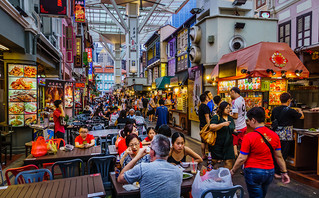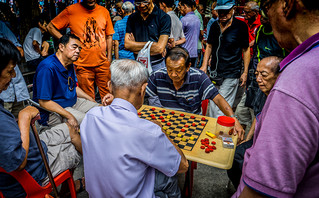In Dan Buettner’s documentary on Netflix‘Live to 100’, features areas around the world that are said to have a higher number of people living much longer than average. The so-called “blue zones” have sparked interest, as experts look for the causes of longevity, such as diet, living conditions, etc. According to a Netflix documentary, the “blue zones” now include Singapore. But to what extent does this claim correspond to reality? Many local experts doubt him.
Dan Buettner has been dealing with “blue belts” for 20 years and has written eight books on the subject. His latest was released last May titled “Blue Belts: Secrets to Living Longer”. The researcher emphasizes that the “Blue Zones” he presents are “confirmed longevity hot spots”. Until today he had defined it as “Blue Zones”. Okinawa in Japan, the Ikariathe Sardinia in Italy, the Nicoya in Costa Rica and Loma Linda in California.
In August, he added Singapore to the list, but made a clarification: He called it an “artificial blue zone” in contrast to the other five regions, which have organically developed their cultures and traditions. “I noticed and called it Blue Zone 2.0 to distinguish it from the other five”he said speaking to Insider and added that he included it in the “Blue Zones” due to the relatively long and healthy life of its population. “I wanted to recognize a city or a country that has produced, according to a modern measurement, the longest healthy population,” he added. .
It’s a theme he touched on in his latest book, where he praised Singapore’s success in “proactively improving the quality of life of its citizens”. As he wrote the island nation is now among the “healthiest, happiest and longest living places on the planet” in the world.
It is a fact that the population in Singapore is living longer. Life expectancy rose to an average of 83 years in 2022, according to official demographic data released by the Singapore government in May. This is an average that is 10 years higher than the global life expectancy of 71 years, according to the World Bank.
And the number of centenarians — people aged 100 or older — doubled from 700 in 2010 to 1,500 in 2020, according to a population trend report. This number corresponds to 0.0002% of the local population.
However, people who live in Singapore every day highlighted to Insider that life in their home country is noticeably different from the descriptions of the other five Blue Zones.
Buettner has described the world’s “Blue Zones” as places that highlight “the inestimable value of slowing down, of long conversations with a neighbor, of family dinners, of eating from the bottom of the food chain, and of cooking at home.”
“I remembered the joy of letting go of the steering wheel and moving on foot. I learned gardening instead of weight training. To come closer to family, to real beauty, to nature and to the rhythms of life that have set the pace of the human species for the last 25,000 generations,” emphasizes Buettner in his latest book, emphasizing, among other things, the healthy home diet.

Citizens of Singapore are “struggling” to find out what of the above is happening in their city. Their lives may have improved compared to previous generations, but the already high cost of living has further increased, as have stress levels and unhealthy eating habits.
THE Andy Ho a psychologist and associate professor at Nanyang Technological University, emphasized how Singapore is a fast-paced and competitive society. “Children and young adults, even at a very young age, learn to compete with others.”
THE Kian Peng Era 54-year-old photographer from Singapore, said that unlike his grandparents’ generation, he and his peers have a better understanding of the importance of healthy eating, but life on the island is “quite stressful”. “The cost of living is high and housing expensive”. “One can live longer only thanks to better medical support. But he’s not healthy and happy”.
Lim, a housewife, said she sees Singapore as a far cry from Buettner’s description of a healthy and happy place: “People in Singapore are usually sleep deprived and don’t exercise as often”. Also, as noted, the level of nutrition is not that good and the stress levels are stressing people out. Both points are confirmed by related reports. Citizens often resort to local fast food because of the low cost, while a survey by insurance company Cigna, which was conducted in April and May 2022, found that Singapore’s stress levels are higher than the global average. Cigna surveyed 1,001 people between the ages of 18 and 65 living in Singapore. Some 86% reported feeling stressed, higher than the global average of 82%.
Also, just last year, the Economist Intelligence Unit named Singapore and New York as the world’s most expensive cities, spanning 172 cities, including major financial hubs such as London and Hong Kong. Sugyanto Suryono, executive director at a nonprofit organization that often volunteers to care for the elderly, said seniors have repeatedly told him they are concerned about the cost of living. “Their main concern is always money,” he stressed. The figures show that a large percentage are struggling to make ends meet, and experts highlight that elderly Singaporeans are “particularly vulnerable to the rising cost of living”.

Several health and public policy experts that Insider spoke with emphasized that Buettner’s “Blue Zones” methodology lacks a clear metric at its core. “The ‘Blue Zones’ designation focuses on life expectancy and healthy life expectancy,” Buettner told Insider, responding to the criticism. “It is not intended to capture other metrics.”
Buettner said Singapore made the Blue Zones list based on the country’s health-adjusted life expectancy data provided to him by the Institute for Health Metrics and Evaluation, a Washington-based research institute. However, it is a fact that Singapore was characterized as a “Blue Zone” with a different method than that previously used in his study by Buettner. In the past. a key component of a Blue Zone according to Buettner himself, involved following people from birth to death in a detailed demographic study.
Buettner underlines for Singapore that is a good example of how a city should be rated, based on factors such as infrastructure, public transport system and food options. He added that Singaporeans may not feel that Singapore is a “blue zone” because they tend not to compare it with the situation in neighboring countries.
In any case, whether Singaporeans believe they live in a “Blue Zone” or not, Ian Ang, an assistant professor at the School of Public Health at the National University of Singapore, believes that “something good can come out of this designation.” .
“The best case scenario is that now, we have a moment to reflect on where we are in achieving better health, not to rest on our laurels and keep working to do better,” he stressed.
Ruben Ng, an assistant professor at the School of Public Policy at the National University of Singapore, said for his part that “Singapore can look like a blue belt from 30,000 feet”. “But the reality is that some of its zones are more “blue” than others. What we should identify is which zones are less blue and focus our efforts to improve them.”
Source: News Beast
With 6 years of experience, I bring to the table captivating and informative writing in the world news category. My expertise covers a range of industries, including tourism, technology, forex and stocks. From brief social media posts to in-depth articles, I am dedicated to creating compelling content for various platforms.







